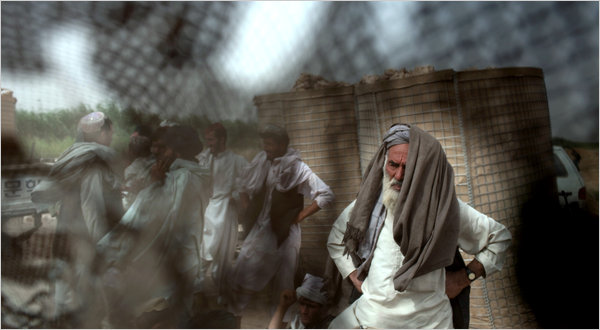
NYT piece by the always astute C.J. Chivers.
As NATO and Afghan forces flow into neighboring Kandahar Province, where for the next many months the latest high-profile effort to undo the Taliban’s hold will unroll, the continuing fighting in Marja can be read as a sign of problems in the American-led surge. It can also be read as something less worrisome: a difficult period in a campaign always expected to be hard.
A prevailing assessment among officers on the ground is this: The outcome is too soon to call.
“Right now it’s gray,” said Maj. Lawrence Lohman, the operations officer for Third Battalion, Sixth Marines, which operates outposts in northern Marja.
Those who deem the Marja offensive a disappointment, or even a failure, point to the daily violence and to the signs that Afghans have been leaving the area, at least temporarily, to avoid the fighting. They also point to Taliban intimidation of residents, a still limited government presence, and the continued reliance of Afghan police officers and soldiers on American supervision and logistics. These, they say, are ill-boding signs.
But the signals are contradictory.
Most of Marja’s civilians returned after moving away ahead of the initial assault. Most of them remain. Compounds that were empty in February are inhabited. Roads once quiet are busy. Fields are thick with crops. Shops in some bazaars have reopened. Afghan units participate visibly in dangerous missions.
Lt. Col. Brian Christmas, the battalion’s commander, noted that some of Marja’s residents had begun providing information on the Taliban, including sharing the names and locations of fighters. Many civilians have been seeking aid and a few have sought contracts for small scale development projects, the early steps in engagement.
“I’ve seen good growth and good progress,” the colonel said. He added: “There is still a lot to be done.”
The Marines point to what they clearly hope is a Helmand pattern, apparent in other districts, including Nawa, where the Taliban were strong and fighting was initially intense. The pattern, they said, is this: With time and resources, the insurgents’ position erodes, villages become secure, and engagement and the Afghan government presence expand.
Pursuing this goal, Marine companies have been sending out constant small patrols.
Time and patience and skills, we seem to have a plenty--at least on the military's side.
More and more we hear generals voicing out loud their thought that Afghanistan will take longer--the implied follow-on being ". . . than President Obama wants."
Obama will reach a Bush moment on Afghanistan, and he will either fold or play on.